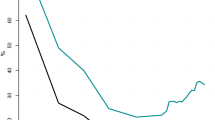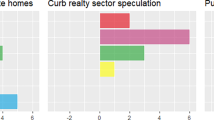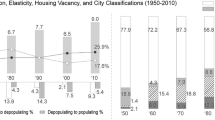Abstract
A model of equilibrium rent determination is developed to incorporate both the scarcity and amenity effects associated with limits to new housing construction in a non-open city where demand for housing has increased. Implications of the model are tested with data from California cities to determine which factors increase the probability that a local growth control ballot measure is proposed, or passed. It is found that limits to new housing development occur with greater frequency in communities where fewer substitute cities exist and where certain socioeconomic characteristics predominate, but not where current population densities, or growth, are high.
Similar content being viewed by others
References
Brueckner, J.K. (1990). Growth controls and land values in an open city.Land Economics 66: 237–248.
Cooley, T.F. and LaCivita, C.J. (1982). A theory of growth controls.Journal of Urban Economics 12: 129–145.
Deacon, R. and Shapiro, P. (1975). Private preference for collective goods revealed through voting on referenda.American Economic Review 65: 943–955.
Fischel, W.A. (1990).Do growth controls matter? A review of empirical evidence on the effectiveness and efficiency of local government land use regulation. Cambridge, MA: Lincoln Institute of Land Policy.
Frech, H.E. II. (1982). The California Coastal Commissions: Economic impacts. In M.B. Johnson (Ed.),Resolving the housing crisis: Government policy, decontrol, and the public interest, 259–274. Cambridge, MA: Pacific Institute and Ballinger.
Frech, H.E. III and Lafferty, R.N. (1976). The economic impact of the California Coastal Commission: Land use and land values. In M.B. Johnson (Ed.),The California coastal plan: A critique, 69–91. San Francisco: Institute for Contemporary Studies.
Frech, H.E. III and Lafferty, R.N. (1984). The effect of the California Coastal Commission on housing prices.Journal of Urban Economics 16: 105–123.
Glickfeld, M., Graymer L. and Morrison, K. (1987). Trends in local growth control ballot measures in California.Journal of Environmental Law and Economics 6: 111–158.
Horner, E.R. (Ed.) (1988).California cities, towns, and counties: Basic data profiles for all municipalities and counties. Palo Alto: Hornwood Press.
Katz, L. and Rosen, K.T. (1987). The interjurisdictional effects of growth controls on housing prices.Journal of Law and Economics 30: 149–160.
Schwartz, S.I., Hansen, D.E. and Green, R. (1981). Suburban growth controls and the price of new housing.Journal of Environmental Economics and Management 8: 303–320.
Schwartz, S.I., Zorn, P.M. and Hansen, D.E. (1986). Research design issues and pitfalls in growth control studies.Land Economics 62: 223–233.
Sonstelie, J.C. and Portney, P.R. (1978). Profit maximizing communities and the theory of local public expenditure.Journal of Urban Economics 5: 263–277.
Author information
Authors and Affiliations
Additional information
The author wishes to acknowledge the help he received from Jon Sonstelie, Robert T. Deacon and H.E. Frech III. The paper also benefits from comments offered at the 1992 Public Choice Society meetings in New Orleans and the 1992 Western Economic Association meetings in San Francisco, and from the suggestions of an anonymous referee. Any remaining errors are the author's. Funding was provided by a CSU San Bernardino Faculty Professional Development Grant.
Rights and permissions
About this article
Cite this article
Richer, J. Explaining the vote for slow growth. Public Choice 82, 207–223 (1995). https://doi.org/10.1007/BF01047694
Accepted:
Issue Date:
DOI: https://doi.org/10.1007/BF01047694




